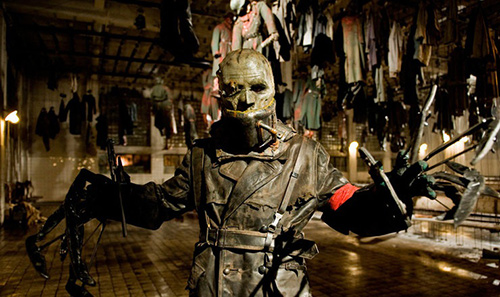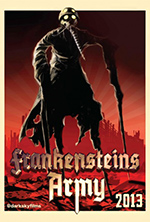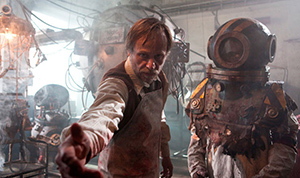 |
|
At The Picture Show
|
August 2013
Frankenstein's Army



The hinterlands are alive, with the sound of mutants
'Frankenstein's Army' wastes great material with its useless visual scheme

Frankenstein's Army
MPI Media Group
Director: Richard Raaphorst
Screenplay: Chris W. Mitchell and Miguel Tejada-Flores
Starring: Alexander Mercury, Karel Roden, Joshua Sasse, Andrei Zayats, Luke Newberry and Robert Gwilym
Rated R / 1 hour, 24 minutes
Now playing in limited release and VOD

 (out of four)
(out of four)
When the histories are written, the crowning achievement of the found-footage craze (I'm resisting the urge to say "era") will be that it took good concepts and terrific production designed and ruined them with shoddy camerawork and illogical stylistic execution. It's the rise of Amateur Chic, all in the name of some vague aesthetic choice whose theoretical purpose has been all but ignored. We've seen it time and again, a movie like this sabotaged by its own gimmick.
That has rarely been more clear than it is in Frankenstein's Army, a campy, sci-fi/horror/video game hybrid with an eminently loveable sense of B-movie ingenuity bogged down by miserable execution. Here all the flaws of the format are present and accounted for - most notably the nonsensical justification for the presence of a camera in the first place. It takes place during World War II, yet the 16mm film is not only immaculately well-preserved, but it's in full color and widescreen, to boot. Those little technical incongruities might seem like nitpicking, if only the entire point of the movie's stylistic choice weren't based around them.
A Russian military outfit uncovers the obscene experimental handiwork of a mad Nazi doctor and, luckily enough, has a cameraman around to document it all. This cameraman, named Dmitri (natch) and played by Alexander Mercury, continues to hold his camera directly in his line of sight even as stitched-together, generator-powered machine/human hybrids are charging toward him, swinging their arm-blades toward his throat. Yep, good ol' Dmitri is perfectly calm, holding the camera steady as he can while running, jumping, fighting, and otherwise escaping certain death. (Say what you will about The Blair Witch Project, at least it understood and embraced the limitations of its technique.)
 That the footage itself is being captured in a way that I believe would have been technically impossible - or at least highly improbable - at the time the movie takes place is of no relevance to director Richard Raaphorst, whose repeated attempts to inject story-related reasons to justify his stylistic conceit only underscore how much of a glaring anachronism it truly is. (The superficial scratches and flaws only draw more attention to how modern and minty-fresh the visuals look.) Eventually we'll get to a point where someone will make a "found-footage" movie set in a time before the invention of cameras, and just hope no one notices or cares.
That the footage itself is being captured in a way that I believe would have been technically impossible - or at least highly improbable - at the time the movie takes place is of no relevance to director Richard Raaphorst, whose repeated attempts to inject story-related reasons to justify his stylistic conceit only underscore how much of a glaring anachronism it truly is. (The superficial scratches and flaws only draw more attention to how modern and minty-fresh the visuals look.) Eventually we'll get to a point where someone will make a "found-footage" movie set in a time before the invention of cameras, and just hope no one notices or cares.
Frankenstein's Army comes close, at least in terms of hoping that the audience is too dense, forgiving or indifferent to notice how poorly the technique is being utilized. Aside from a couple of great reveal shots (which, by the way, could have been pulled off the exact same way without the POV gimmick) and one particular sequence in which Raaphorst and cinematographer Bart Beekman do a nice job navigating their surroundings during a complex action sequence, the usefulness of the format is all but lost.
The shame is how much it detracts from the film's ideas. I kind of wanted to love the movie just for the wild inventiveness of its visual designs. The mad doctor's inventions - the combination of dead or dying flesh with all kinds of machinery, like an army of humanoid Swiss Army knives - are absolutely terrific work. There's a grubby, handmade feel to every creature, each of which has its own unique look. They're like a bunch of enlarged, metallic insects made up of mismatched body parts.
Given the film's roots in 19th and 20th Century horror/sci-fi literature (namely the titular Shelley influence, which is referenced in a few clever ways - including a great Bride of Frankenstein visual allusion), it's no surprise that it reminded me of Guillermo del Toro's own creature designs, as well as the likes of Tim Burton. (An evil, bizarro version of Edward Scissorhands might feel right at home in this lab.)
I'm not exaggerating when I say that production designer Jindrich Kocí, art director Milena Koubkova and costume designer Hana Rambova are all worthy of Oscar consideration (though of course they'll all be overlooked in favor of five Victorian-era period pieces). But their innovations are unfortunately used in service to a film that, as a whole, doesn't have nearly the same level of vision. Raaphorst and co-writers Chris W. Mitchell and Miguel Tejada-Flores didn't really construct much of a story to support this army of misfit machinery. And they certainly never figured out the best way to actually shoot the thing. If they'd given it a bit more thought, perhaps they never would have gone for the found-footage approach in the first place, and perhaps Frankenstein's Army would have come closer to fulfilling its rich conceptual potential.
Read more by Chris Bellamy